AAC Implementation Framework: Step 3 “Take In”
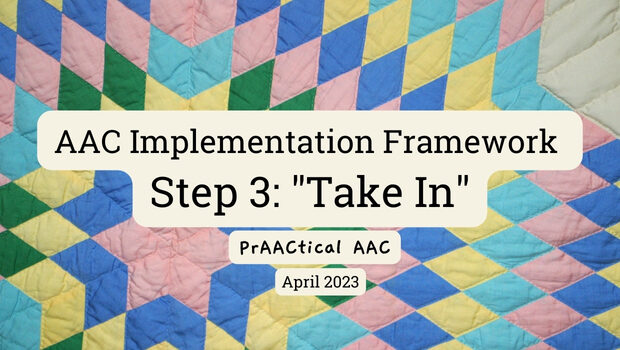
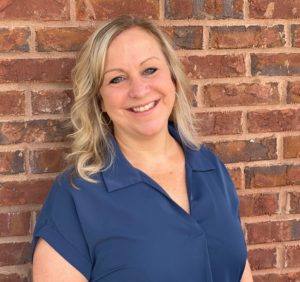 Welcome to the next installment of Vicki Clarke’s AAC Implementation Framework. In today’s post, Vicki focuses on the role of the communication partner, with prAACtical ideas for helping them utilize key support strategies that facilitate AAC learning.
Welcome to the next installment of Vicki Clarke’s AAC Implementation Framework. In today’s post, Vicki focuses on the role of the communication partner, with prAACtical ideas for helping them utilize key support strategies that facilitate AAC learning.
New to this series? You find the earlier posts using the links below.
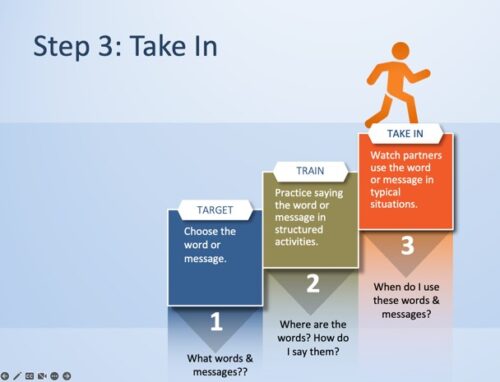 :::::::::::::::::::::::::::::::::::::::::::::::::::::::::::::::::::::::::::::::::::::::::::
:::::::::::::::::::::::::::::::::::::::::::::::::::::::::::::::::::::::::::::::::::::::::::
AAC Implementation Framework
Step 3: “Take In”
In our journey towards teaching autonomous communication, Step 3: “Take In” is dedicated to the partner’s role, which involves modeling the use of AAC to communicate words and messages in real-world situations. The aim of this stage is to help the student learn when and how to communicate using AAC, as well as to develop a clear understanding of the practical application of these skills by watching their partner’s interactions. This process mirrors the way in which infants and toddlers acquire language, as they observe and experience their parents and other adults conversing with one another for genuine purposes.
What does modeling look like? Take 6 minutes and check out this wonderful explanation from the Communication Technology Education Center!
Direct Link to Video – https://www.youtube.com/watch?v=VppaSuAF0f4&ab_channel=CTECCommunicationTechnologyEducationCenter
Top of Form
Modeling is one of the MOST researched techniques proven to positively impact a student’s development of communication competence through AAC. But when we talk about modeling, we mean a LOT of modeling, as much as 200x a day. But for now, don’t panic; start small and get the hang of it first. You may only choose ONE word or message to model on your first day, and that is OKAY! Just keep adding new words to your modeling repertoire each day!
When you have those moments when you are wondering WHY you are working so hard on this, rest assured that there is plenty of research to inspire you! Here on PrAACtical AAC, Carole Zangari has curated a ton of research articles to ensure that you are on the right track! 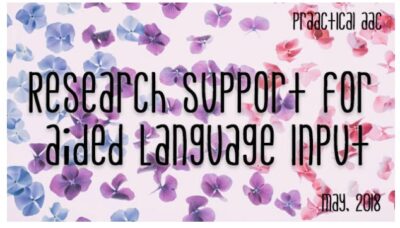
Keep these articles around because it never hurts to have a ready explanation of your process to your administrators, families, and other team members!
Modeling seems easy; you just use the AAC system to say the words while you are saying them. BUT when you first begin to model communicating this way, it seems AWKWARD. This is because you are generally a competent communicator. When you add the component of a new way of communicating, for example, using picture symbols, you will at first become less of a competent communicator. We educators typically are quite averse to this feeling of incompetence. Often, we hate it so much that it is very difficult for us to start this process. The trick here, I believe, is to understand that it’s going to be messy! And that’s OK! If you acknowledge to yourself and the other adults around you that it is not going to be perfect at first, you will allow yourself the grace needed to make mistakes and learn from them. This is a critical concept to move forward in your own journey to becoming a competent AAC communicator. Here are some ideas to get you started and keep you moving towards modeling effectively and consistently for your students.
Tricks to Keep You Modeling!
- PLAN the words you will model BEFORE the activity begins.
- MAKE the materials easily accessible.
- TAKE data on what and how and how often you model.
- REWARD yourself when you meet your own goals for the amount of modeling you complete! Starbucks for modeling during 5 activities in a day?
One of the simplest ways of identifying words and messages to target during activities is to simply watch what everyone else is doing! One of the ways that we know a person is communicatively competent is their ability to participate fully in the activities of their day. These are the perfect place to start your modeling journey!
- Planning for Modeling: Observe What Everyone Else is Saying!
- Watch the activity and take notes on the words you think the STUDENT will say. (not YOU!)
- Watch other students and see what words THEY are using.
- Planning for Embedding Modeling:
The easiest way to ensure you will remember to model throughout your day is to TIE the modeling habit to daily activities you are ALREADY doing! You can create a simple schedule of your daily activities, then choose one word or message to target during each activity. At DTA Schools, our teachers use a laminated poster grid and dry-erase markers to make this plan and post it in clear sight to remind the adults of the targets!
- Gather readily accessible AAC materials for YOU to use:
- Make a printed copy of the student’s AAC system just for you!
- Download the student’s AAC system on your own iPad
- Put the student’s AAC program on your Smart Board
- Label your environment with printed AAC symbols- Grab and Go!
- Model in a variety of situations
- Structured activities such as core word book reading, core word video and songs
- Planned learning activities such as small group literacy lessons and “morning meeting”
- Naturally occurring activities throughout the day, such as lining up for lunch, “go!” or gathering materials “get!”
Partner modeling is an essential step for students to learn to communicate through AAC. It helps students understand how words and messages are used in real-life situations and how to communicate effectively in different contexts. By immersing students in the language through AAC and showing them how adults use it, they will begin to develop the communication skills they need to interact successfully to engage socially, share information and meet their basic needs.
Direct Link to Video – https://youtu.be/c8JsEHeDGJQ
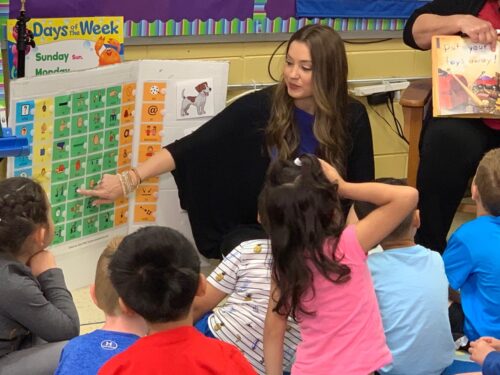 About the Guest Author
About the Guest Author
Vicki Clarke is the CEO of Dynamic Therapy Associates, Inc and Director of DTA Schools, a division of DTA Inc, supporting both individual student growth and, system-wide focus on the development of augmentative communication skills, supports, and best practices in special education programs. Additional professional activities include professional consultation and training through publications, workshops, and presentations at local, state, and national conferences in the areas of AAC, speech-language pathology, special education, and Autism.
Filed under: PrAACtical Thinking
This post was written by Carole Zangari
